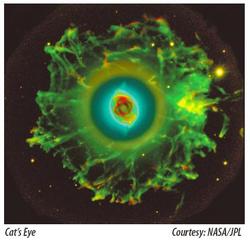Galaxies
The images we are now going to see are not visible within the window of visible light only. Often they are composite images, with data from X ray, UV, infrared etc.
|
|
|
The Cat’s Eye displays very clearly an enormous activity in the sky, at first difficult to explain within a classical gravitation theory. Structures as we see here have been reproduced in laboratory experiments, of course on a much smaller scale. And they have been produced too with computer simulations based on the laws of classical electrodynamics.
The centre of the Cat’s Eye gives a fascinating picture of activity which strongly points to electric behaviour. Please note the cellular structures.
The Ant nebula again shows interactions difficult to explain by traditional gravitation, yet fitting very well within an electrical explanation.
Here we witness the explosion of a star, supposed to be rather similar to our Sun.
This “all seeing eye”corresponds with the Helix nebula – a fascinating constellation.
A last beautiful display of electrical activity: the Orion nebula. Please note the enormous activity of all kinds in this image and the filaments connecting all parts of the constellation.
![[Figures: Cat’s Eye - detail & Cat’s Eye] [Figures: Cat’s Eye - detail & Cat’s Eye]](/var/storage/images/media/images/e_bridge/illustrations/electric_bridge_05/128274-6-eng-GB/electric_bridge_05_medium.jpg)

![[Figure 6: Ant Nebula] [Figure 6: Ant Nebula]](/var/storage/images/media/images/e_bridge/illustrations/electric_bridge_06/128278-4-eng-GB/electric_bridge_06.jpg)
![[Figure 7: Explosion of a Sun-like star] [Figure 7: Explosion of a Sun-like star]](/var/storage/images/media/images/e_bridge/illustrations/electric_bridge_07/128282-4-eng-GB/electric_bridge_07.jpg)
![[Figure 8: Helix Nebula – “All seeing eye”] [Figure 8: Helix Nebula – “All seeing eye”]](/var/storage/images/media/images/e_bridge/illustrations/electric_bridge_08/128286-4-eng-GB/electric_bridge_08.jpg)
![[Figure 9: Orion Nebula] [Figure 9: Orion Nebula]](/var/storage/images/media/images/e_bridge/illustrations/electric_bridge_09/128290-4-eng-GB/electric_bridge_09.jpg)